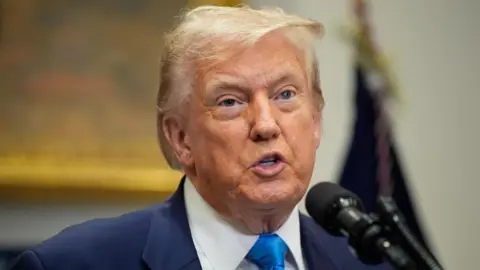In a significant development regarding international trade, President Donald Trump announced a new agreement that will implement a 15% tariff on imports from South Korea. This decision comes as part of a broader effort to renegotiate trade terms with various countries. On Wednesday, Trump shared this news via the Truth Social platform, emphasizing the positive aspects of the deal, which he claims will benefit both the United States and South Korea.
The President expressed his satisfaction with the agreement, stating, “I am pleased to announce that the United States of America has agreed to a Full and Complete Trade Deal with the Republic of Korea.” This upbeat announcement suggests that the new tariff rate is viewed as a preferable alternative to the previously proposed higher levies, which would have soared to as much as 25% if negotiations had failed. South Korean President Lee Jae Myung responded positively, indicating that the arrangement would place his country on an equal or potentially advantageous level compared to other trading nations.
The urgency of reaching this deal is underscored by the impending deadline of August 1, the day after which countries that had not negotiated agreements with the United States would face escalated tariffs. South Korea’s negotiation success not only averts a potential financial burden but also underscores the importance of diplomatic engagement in trade matters, showcasing how critical these discussions have become in the current geopolitical landscape.
Financial commitments are an essential aspect of this agreement, with South Korea promising to invest $350 billion—estimated at approximately £264.1 billion—into US projects specifically chosen by President Trump. Additionally, this new trade framework includes a provision wherein South Korea will purchase $100 billion worth of liquefied natural gas and other energy resources from the US. This aspect suggests that energy trade is becoming a pivotal element in the bilateral relations between the two nations, reflecting broader trends in global energy security and economics.
Trump also specified that under the new trade terms, South Korea is expected to welcome American products—including vehicles and agricultural goods—into its market without imposing any import tariffs on them. This reciprocal arrangement is intended to enhance market access for US goods, potentially stimulating American exports and supporting the domestic manufacturing sector.
Lee Jae Myung is expected to visit the White House within the next two weeks to further discuss the nuances of this deal with Trump. The upcoming meeting will likely focus on the implementation strategies and mutual benefits envisioned from this trade partnership. Since his return to office in January, Trump has adopted a stance favoring significant import tariffs on various goods, while also signaling threats of additional tariffs in the future.
The broader implications of Trump’s trade approach raise various points of contention. Proponents argue that tariffs are a means of bolstering American manufacturing capabilities and protecting jobs domestically. Conversely, critics warn that such import taxes have contributed to an unstable global economic environment, often leading to increased prices for US consumers. The volatility in international trade policy under the Trump administration remains a point of debate among economists, policymakers, and the business community.
As this trade deal takes shape, the future of US-South Korean relations will be watched closely by observers around the world. It serves as a testament to the shifting dynamics of global trade, where tariffs and diplomatic negotiations play increasingly crucial roles in determining economic outcomes for nations involved. The evolution of this agreement could set precedents for future trade discussions not only with South Korea but also with other nations affected by Trump’s aggressive tariff strategies.












